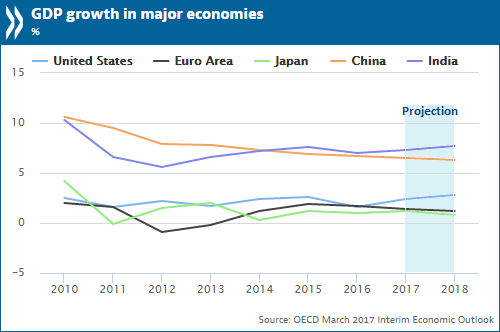Analytics, EU – Baltic States, Forum, Modern EU
International Internet Magazine. Baltic States news & analytics
Tuesday, 16.12.2025, 19:53
OECD suggestion: “better life for all” is real
 Print version
Print version |
|---|
The MCM discussed
the need for inclusive growth to improve well-being for all in open, digitally
advanced economies and work to define a more people-centered approach to
international regulations. It highlighted the importance of continuing
countries’ focus on developing more integrated, and inclusive economies and
societies. This MCM echoes the pledge of the UN-2030 Agenda for Sustainable
Development to “Leave No One Behind”.
Making globalisation work for better lives for all was the main message at the OECD forum.
Bridging divides
The central focus
of the forum will be on “bridging divides” apparent presently. Divides
have become apparent globally and regionally on a number of fronts; among main
divides are: increasing populism and nationalism, historically low levels of
trust, rapid pace of technological development, and continued effects of the
crisis. These and some other “divides” are having a disruptive impact on
societies and countries’ economies.
Ministers were discussing, notably: global general economic outlook, the
opportunities and challenges of economic integration, the challenges of
globalisation; domestic policies to ensure people, firms, regions and cities
can thrive in an open and digitalised environment; building inclusive
globalisation; as well as international trade and investment for the benefit of
all.
http://www.oecd.org/general/oecd-week.htm
Economic outlook
Global economic
growth is expected to pick up modestly in 2018 to around 3.6 % from a projected
3.3% in 2017 but risks of rising protectionism, financial vulnerabilities,
potential volatility from divergent interest rate paths and disconnects between
market valuations and real activity have been underlined in the OECD’s 2017
outlook.
Table: GDP in major global economies

The projected
improvement largely reflects continuing and expected combined fiscal and
structural initiatives in the major economies - notably China, Canada and the
United States - together with a slightly more expansionary stance in the euro
area, which could be more ambitious. Such policies are needed to catalyse
private demand to boost global activity and reduce inequalities.
Global economic outlook
The global
economy portrayed by the Interim Economic Outlook
remains beset by sub-par GDP growth and high inequality, calling for policy
responses that advance inclusive growth in the context of increased economic
integration.
Commenting on the
Outlook, OECD Secretary-General Angel
Gurría said: “Growth is still too weak and its benefits too narrowly
focused to make a real difference to those who have been hit hard by the crisis
and who are being left behind. Now, more than ever, governments need to take
actions that restore people’s confidence while at the same time resisting
turning inwards or rolling back many of the advances that have been achieved
through greater international co-operation.”
The OECD’s
Interim Economic Outlook examines some of the many risks that could derail the
projected modest upturn in global growth.
Foremost
among these there is the risk of rising protectionism that would hurt global
growth and impact the large number of jobs that depends on trade. The rapid
growth of private sector credit and the relatively high level of indebtedness
is a key risk in a number of emerging markets, above all in China, and housing
valuations are a matter of concern in some advanced economies.
The
strength of financial market valuations appears disconnected to the outlook for
the real economy, where the growth of consumption and investment remains
subdued. There is also a risk of global financial market tensions as interest
rates adjust and diverge across the major economies. The social cost
of the crisis and the increased inequalities need to be addressed to make growth
more inclusive and to reduce pressures for protectionism and other populist
responses.
OECD Chief
Economist Catherine L. Mann said:
“The pick-up in growth from countries taking fiscal initiatives is broadly
welcome, but we cannot ignore the danger that the recovery gets knocked off
track by policy errors or financial risks and vulnerabilities. Coherent and
committed policy action is needed to simultaneously raise growth rates and
improve inclusiveness.”
Citations from: www.oecd.org/economy/economicoutlook.htm
Situation in some countries
In the United
States, domestic demand is set to strengthen, helped by gains in household
wealth and a gradual upturn in oil production. GDP growth is expected to pick
up to 2.4% this year and 2.8% in 2018, supported by an anticipated fiscal
expansion, despite higher long-term interest rates and a stronger dollar.
The
moderate pace of growth is expected to continue in the euro area but is being
held back in some countries by stubbornly high unemployment and underemployment
(particularly of youth) as well as by
banking sector weakness. GDP for the area as a whole is expected to expand at
an annual rate of 1.6% in both 2017 and 2018.
In Japan, fiscal easing and improvements to women’s labour force participation will help GDP growth pick up this year to 1.2% from 1.0% in 2016. Prospects will depend on the extent to which labour-market duality is reduced and wage growth picks up.
Growth in
China is projected to slip further to 6.5% this year and to 6.3% in 2018 as the
economy makes a necessary transition away from a reliance on external demand
and heavy industry toward domestic consumption and services.
Higher
commodity prices and easing inflation are supporting a recovery from deep
recessions in Brazil and Russia, underlines OECD report.
The OECD
says governments need to manage risks, enhance economic resilience and
strengthen the environment to boost growth, with improvements in both
productivity and inclusiveness. Focusing on policies that build structural
elements into fiscal initiatives would reduce the burden on monetary policy in
the advanced economies and help to boost trade, investment, productivity and
wages.
The Interim
Economic Outlook and additional information is on the following web link: www.oecd.org/economy/economicoutlook.htm.
Economic and financial conditions for growth
The Economic
Outlook forecasts and accompanying analyses are conditional on a consistent set
of assumptions about policies and underlying economic and financial conditions,
including fiscal and monetary policy settings, exchange rates, commodity prices
and international financial markets.
- Macroeconomic policies. Macroeconomic policies are typically
assumed to be "unchanged" over the projection period and on the basis
of current fiscal and monetary policies. This does not mean that the OECD
necessarily assumes that governments will – or should - achieve their stated
objectives, or that policies themselves may not adapt to differing economic
circumstances. Rather the OECD forecasts represent the likely outcomes for
growth, inflation, employment and other key economic variables for given
unchanged policy settings.
- Fiscal policies. Fiscal policy assumptions are based as closely as possible on legislated tax and spending provisions. Where government plans have been announced but not legislated, they are incorporated if it is deemed clear that they will be implemented in a shape close to that announced. Otherwise, in countries with impaired public finances, a tightening of the underlying primary balance by a certain percentage of GDP is built into the projections.
- Domestic monetary policies. The monetary policy assumptions take into
account a range of monetary and financial indicators, including policy
announcements with respect to the choice of monetary targets, associated target
ranges and policy instruments, by the national authorities. Policy
controlled short-term interest rates are typically assumed to be set in line
with the stated objectives of the relevant monetary authorities, conditional
upon the OECD projections of activity and inflation, which may differ from
those of the monetary authorities. The resulting interest rate profiles
should therefore not to be interpreted as a projection of central bank
intentions or market expectations thereof.
The resulting
paths of short-term interest rates are assumed to feed into long term interest
rates in a manner consistent with the usual expectations hypothesis of the term
structure of interest rates, by which long-term interest rates are an average
of future short-term rates. In addition, account is taken of the term premia,
the extra amount of yield that investors in longer-term bonds in each economy
require as compensation for the risk of capital losses and/or lack of
liquidity.
For countries
with government gross debt exceeding 75 percent of GDP, the term premium is
assumed to rise with the level of debt.
- Exchange rates. Nominal exchange rates against the US dollar are
set by technical assumption to remain constant over the projection period, at
levels prevailing on a pre-specified cut-off date. The corresponding profiles
of nominal and effective exchange rates beyond the current year are therefore
typically constant for all countries and regions.
There are two
reasons for using such a simple technical assumption. Firstly, specific
exchange rate forecasts continue to be politically and market sensitive for many
countries and areas. At the same time, short-term exchange rate movements are
typically quite difficult to predict and, in practice, a naive random-walk
model – one assuming nominal rates to remain broadly at current levels - is
often found to be no less accurate than predictions based on more complex
econometric or statistical relationships.
Nonetheless, to
the extent that underlying economic conditions or associated risks may at times
suggest possible systematic upward or downward pressures on major currencies,
the wider economic consequences of such movements are routinely explored as
alternative scenarios, based upon macro-econometric simulations.
- Oil and non-oil commodity prices. The price of a barrel of Brent crude oil
is assumed to increase at a rate of $5 per year ($1.25 per quarter) from its
observed level when the projections close. Non-oil commodity prices are assumed
to be constant over the projection period at their observed levels when the
projections close.
References in: http://www.oecd.org/eco/economicoutlook.htm








 «The Baltic Course» Is Sold and Stays in Business!
«The Baltic Course» Is Sold and Stays in Business!

